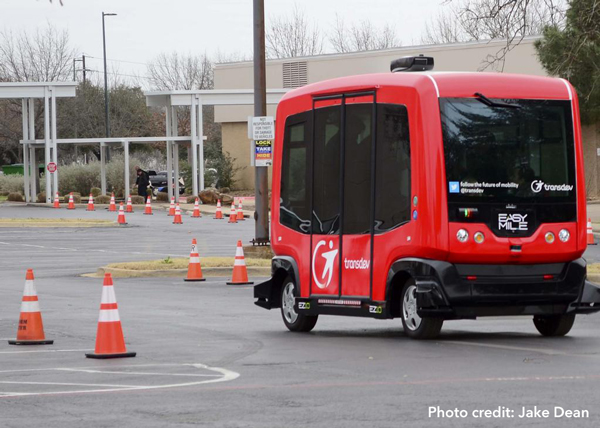June 23, 2017
Guest op-ed by Lauren Isaac, Director of Business Initiatives, EasyMile.
Automated vehicles are getting a substantial amount of news coverage these days, and for good reason: once they are capable of driverless operation, they may create new efficiencies in our over-scheduled lives by carrying out tasks such as picking up groceries, taking our kids to soccer practice, and parking themselves remotely after dropping us off at our workplaces.
Driverless vehicles will be safer and more reliable than the manually-driven alternative, and will create new solutions for disabled individuals. Take a closer look at the reporting on this new phenomenon, however, and you’ll notice that the vast majority of articles on automated vehicles focus on passenger cars. Moreover, these articles do not often address the potential downsides of passenger driverless cars.
For example, driverless passenger vehicles will likely increase both single-occupancy vehicle trips and the unprecedented zero-occupancy vehicle trips, creating more carbon emissions and adding more cars to already-congested roads. And, depending on the price point of a driverless vehicle (and other factors), people may forgo public transit in favor of taking their own driverless car, which will provide many of the same individual benefits as a train or bus (working, listening to podcasts, etc. while commuting) and potentially reduce the demand for public transit.
While not necessarily a negative implication, interested individuals should temper their expectations for personal driverless cars, which require Level 5 (full) automation. Driverless experts estimate that this level of automation could still be years, if not decades, away. Much of the hype in the news today refers to partial automation.
Driverless shuttles, which get far less press coverage, deserve a closer look. These vehicles provide an antidote to many of the concerns cited about driverless passenger cars. First and foremost, they provide a “green” alternative: these vehicles are shared, much the same as any other form of public transit, thereby avoiding single- and zero-occupancy vehicle trips. Secondly, driverless shuttles can operate autonomously or semi-autonomously today in contained environments such as campuses, airports, and employment centers. This could provide a first/last mile solution to augment public transit networks, allow individuals to park remotely, and increase mobility in a specific area. Finally, driverless shuttles provide an opportunity for immediate adoption: state and local governments can already partner with driverless shuttle companies to provide additional public transit alternatives to their constituents.
In fact, there are examples of driverless shuttle deployments available around the world: in Paris, rail passengers took driverless shuttles between train stations during a 3-month demo. In Singapore, tourists can hop on a driverless shuttle to circle the Botanical Garden. And starting in July 2017, football fans will be able to park their cars and travel via driverless shuttle to one of the world’s largest sports arenas in Arlington, Texas. At EasyMile, we have already seen a number of successful driverless shuttle deployments around the world through partnerships with public and private entities.
Both the public and private sectors are taking notice of the tangible benefits of driverless shuttles. Many high-profile pilot tests are already underway around the world, and the technology underlying autonomous vehicles is rapidly progressing.
There are several reasons that entities like Contra Costa Transportation Authority (CCTA) and Arlington, Texas decided to create pilot programs for driverless shuttles sooner rather than later:
- Public Acceptance: Many polls show that individuals would not ride in a driverless vehicle. Pilots present an opportunity for riders to see and touch the vehicles, which helps them to really process how they could integrate driverless vehicles into their lives.
- Stakeholder Education: While some individuals may be “sold” on driverless technology and its potential, there are often board members, officials and others that still need to be convinced. Pilots present a short-term, affordable way to introduce the technology to decision-makers without any significant commitments (especially since no infrastructure changes are needed).
- Formation of Partnerships: The driverless ecosystem has many players, including insurance providers, universities, parts suppliers, and privacy/cyber-security experts. The sooner the technology is introduced, the sooner an agency can determine which relationships are necessary, establish their objectives, and begin forging relationships with these new players.
- Navigating Regulations: Regulations impacting driverless vehicles are being developed right now. Public and private sector entities that introduce driverless technology can have a seat at the table and actually influence the regulations at both the federal and state levels by being active participants in the discussion as early adopters. At present, the relevant regulators are receiving a lot of input from technology developers, but they need to hear from other stakeholders as well.
- Integration with Public Transit: As driverless technology is tested and implemented, transit agencies can start to explore how driverless vehicles can be integrated with their existing operations, fare structure, staffing, etc., and help them understand how to incorporate driverless technology into their short- and long-range plans.
While most of buzz around automated vehicle technology seems to be about driverless passenger vehicles, the public and private sectors have an opportunity to focus on driverless shuttles today, with a lot of potential upside. Right now, pilot programs are demonstrating that driverless shuttles can improve safety, reduce greenhouse gas emissions, augment mobility options, and integrate with other transportation modes for more rider efficiency. Many pilot programs are underway and success stories abound. What are you waiting for?
Lauren Isaac is the Director of Business Initiatives for the North American operation of EasyMile. Easymile provides electric, driverless shuttles that are designed to cover short distances in multi-use environments. The views expressed above are not necessarily those of the Eno Center for Transportation.





